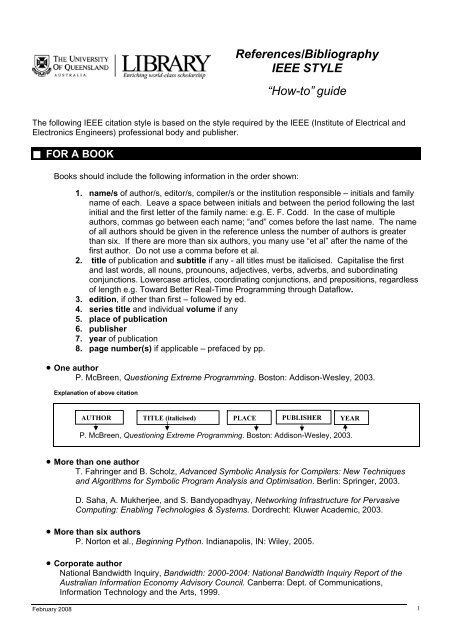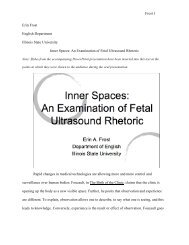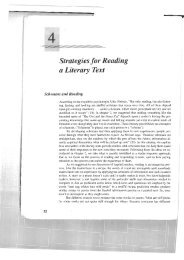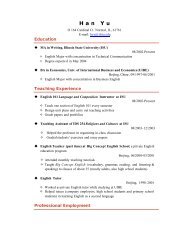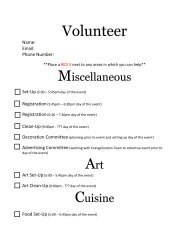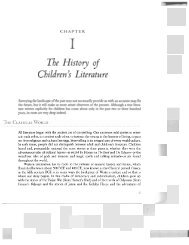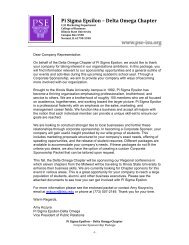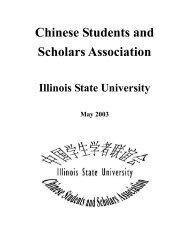References/Bibliography IEEE STYLE âHow-toâ guide
References/Bibliography IEEE STYLE âHow-toâ guide
References/Bibliography IEEE STYLE âHow-toâ guide
- No tags were found...
Create successful ePaper yourself
Turn your PDF publications into a flip-book with our unique Google optimized e-Paper software.
<strong>References</strong>/<strong>Bibliography</strong><strong>IEEE</strong> <strong>STYLE</strong>“How-to” <strong>guide</strong>The following <strong>IEEE</strong> citation style is based on the style required by the <strong>IEEE</strong> (Institute of Electrical andElectronics Engineers) professional body and publisher.• FOR A BOOKBooks should include the following information in the order shown:1. name/s of author/s, editor/s, compiler/s or the institution responsible – initials and familyname of each. Leave a space between initials and between the period following the lastinitial and the first letter of the family name: e.g. E. F. Codd. In the case of multipleauthors, commas go between each name; “and” comes before the last name. The nameof all authors should be given in the reference unless the number of authors is greaterthan six. If there are more than six authors, you many use “et al” after the name of thefirst author. Do not use a comma before et al.2. title of publication and subtitle if any - all titles must be italicised. Capitalise the firstand last words, all nouns, prounouns, adjectives, verbs, adverbs, and subordinatingconjunctions. Lowercase articles, coordinating conjunctions, and prepositions, regardlessof length e.g. Toward Better Real-Time Programming through Dataflow.3. edition, if other than first – followed by ed.4. series title and individual volume if any5. place of publication6. publisher7. year of publication8. page number(s) if applicable – prefaced by pp.• One authorP. McBreen, Questioning Extreme Programming. Boston: Addison-Wesley, 2003.Explanation of above citationAUTHORTITLE (italicised)PLACEPUBLISHERYEARP. McBreen, Questioning Extreme Programming. Boston: Addison-Wesley, 2003.• More than one authorT. Fahringer and B. Scholz, Advanced Symbolic Analysis for Compilers: New Techniquesand Algorithms for Symbolic Program Analysis and Optimisation. Berlin: Springer, 2003.D. Saha, A. Mukherjee, and S. Bandyopadhyay, Networking Infrastructure for PervasiveComputing: Enabling Technologies & Systems. Dordrecht: Kluwer Academic, 2003.• More than six authorsP. Norton et al., Beginning Python. Indianapolis, IN: Wiley, 2005.• Corporate authorNational Bandwidth Inquiry, Bandwidth: 2000-2004: National Bandwidth Inquiry Report of theAustralian Information Economy Advisory Council. Canberra: Dept. of Communications,Information Technology and the Arts, 1999.February 2008 1
• Chapter or part of a bookA chapter of a book should include the following information in the order shown:L. Rosenfeld and P. Morville, “Designing Navigation Systems,” in Information Architecture forthe World Wide Web, 2nd ed., Sebastopol, CA: O'Reilly, 1998, pp. 47-71.• FOR AN ARTICLEJournal articles should include the following information in the order shown.1. name/s of author/s of the article. Leave a space between initials and between the periodfollowing the last initial and the first letter of the family name: e.g. E. F. Codd. In the caseof multiple authors, commas go between each name; “and” comes before the last name.If there are more than six authors, you may use “et al” after the name of the first author.Do not use a comma before et al.2. title of article - in double quotation marks3. title of periodical – italicised; can be abbreviated. <strong>IEEE</strong> journal titles are abbreviatedaccording to the List of <strong>IEEE</strong> Transactions, Journals and Letters4. volume number - use lowercase for vol.5. issue (or part) number – use lowercase for no. Issue number is not used whenreferencing <strong>IEEE</strong> Transactions6. page number(s)7. date of publication• Journal articleJ. Canosa, “Ultrawideband and WiMedia,” Embedded Systems Programming, vol. 16, no. 4,pp. 29-36, Apr. 2003.Explanation of above citationAUTHOR TITLE OF ARTICLE TITLE OF JOURNAL VOLUME ISSUE PAGE DATEJ. Canosa, “Ultrawideband and WiMedia,” Embedded Systems Programming, vol. 16, no. 4, pp. 29-36, Apr. 2003.• eJournal articleJ. Case, D. S. Rajan, and A. M. Shende. (2001, Jan.) Lattice Computers for ApproximatingEuclidean Space. Journal of the ACM [Online]. 48(1), 110-144. Available:http://portal.acm.org/citation.cfm?id=363688&coll=portal&dl=ACM&CFID=1141529&CFTOKEN=57117280• Conference articleConference papers should include the following information in the order shown:R. Hambli, “BLANKSOFT : A Computer Aided Manufacturing System for Metal BlankingProcesses Design,” presented at the <strong>IEEE</strong> International Conference on Systems, Man, andCybernetics, Yasmine Hammamet, Tunisia, Oct. 2002.• FOR A TECHNICAL REPORTTechnical reports should include the following information in the order shown:1. author/s of report2. title of report – in quotes3. publisher4. place of publication5. report number / identifier (if known)6. date of publicationFebruary 2008 2
K. Forbus and M. Seif El-Nasr, “Artificial Intelligence and Interactive Entertainment: Papersfrom the 2002 AAAI Symposium, March 25-27, Stanford, California,” AAAI Press, MenloPark, Calif., Tech. Rep. SS-02-01, 2002.• FOR A STANDARDStandards should include the following information in the order shown:1. title of standard (italicised)2. standard number3. date<strong>IEEE</strong> Standard Signalling Method for a Bidirectional Parallel Peripheral Interface for PersonalComputers, <strong>IEEE</strong> Standard 1284, 2000.• FOR A PATENTPatents should include the following information in the order shown:G. Brandli and M. Dick, “Alternating current fed power supply,” U.S. Patent 4084217, 1978.• FOR A THESISTheses should include the following information in the order shown:R. Colvin, “Contextual and data refinement for the refinement calculus for logic programs,”PhD thesis, The University of Queensland, Australia, 2002.• FOR ELECTRONIC RESOURCES<strong>References</strong> to electronic resources are acceptable but where a printed copy exists it is preferablyto reference the print version. Electronic resources should contain as much information aspossible. If the address must run across more than one line, follow these <strong>guide</strong>lines:• Break only after a forward slash or a “dot”.• Do not split the double slash.• Do not split at hyphens, tildes, and so on, that are part of the address.• Do not introduce hyphens to break words.• Separating the extension is discouraged (for e.g. the html at the end).Article:J. Case, D. S. Rajan, and A. M. Shende. (2001, Jan.) “Lattice Computers for ApproximatingEuclidean Space”, Journal of the ACM [Online]. 48(1), 110-144. Available:http://portal.acm.org/citation.cfm?id=363688&coll=portal&dl=ACM&CFID=1141529&CFTOKEN=57117280Internet site:Engineers Without Borders Australia, “Annual Report 2005-2006,” Engineers WithoutBorders. [Online]. Available:http://www.ewb.org.au/resource/file/299_Annual_Report_0607-low_res_final.pdf• IN-TEXT REFERENCES• The <strong>IEEE</strong> style is a numbered style. In a numbered style, a textual citation requires the number ofthe reference to be enclosed in square brackets.• <strong>References</strong> must be numbered in the order in which they appear in the text.February 2008 3
• This may appear at the end of a sentence, before the full stop or directly following the name of theauthor.• Separate references to two or more works by different authors with a comma.• If referring to more than two sequential references separate the first and last reference with an endash between the square brackets.• The full references appear at the end of your work in a Reference List or a <strong>Bibliography</strong>.ExamplesCase [1] and Canosa [2] both investigate the use of computing power in an efficient manner.Canosa advocates a more stringent approach [2].Subsequent investigation confirmed these results [1, 2, 4].Other researchers have questioned these findings [1] – [4].• BIBLIOGRAPHY / LIST OF REFERENCES• <strong>References</strong> must be listed in the order in which they were cited in the text.• List only one reference per bracketed number.Examples[1] P. McBreen, Questioning Extreme Programming. Boston: Addison-Wesley, 2003.[2] T. Fahringer and B. Scholz, Advanced Symbolic Analysis for Compilers: New Techniquesand Algorithms for Symbolic Program Analysis and Optimisation. Berlin: Springer, 2003.[3] D. Saha, A. Mukherjee, and S. Bandyopadhyay, Networking Infrastructure for PervasiveComputing: Enabling Technologies & Systems. Dordrecht: Kluwer Academic, 2003.[4] P. Norton et al., Beginning Python. Indianapolis, IN: Wiley, 2005.NOTE: • A list of references contains details only of those works cited in the text.• A bibliography includes sources not cited in the text but which are relevant tothe subject, listed alphabeticallyIf you require further information, refer to:For print and<strong>IEEE</strong> (Institute of Electrical and Electronics Engineers) Styleelectronic sources Manualhttp://www.ieee.org/portal/cms_docs_iportals/iportals/publications/authors/transjnl/stylemanual.pdfAsk at the Information Desk in any Branch Library or check theLibrary’s Web Page ~ http://www.library.uq.edu.au/infoskil/styles2.htmlFebruary 2008 4


